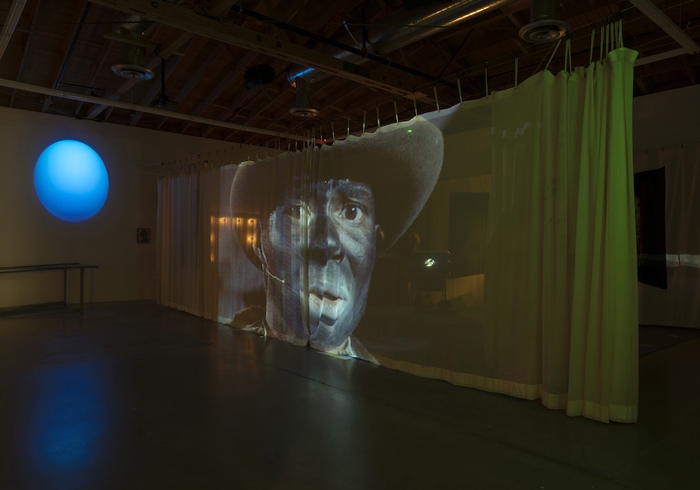Susanne Vielmetter Los Angeles Projects, 27 May – 1 July
One enters immediately upon a stage set. Over a ghostly scrim plays a projection of a 2015 performance, written by Arceneaux, after which the exhibition is titled; one scene shows a man singing Waiting for the Robert E. Lee (1912) – poignant at a time when monuments to the rebel confederacy are being taken down throughout the American South. Arceneaux’s projection periodically reveals an audience, sitting in the gallery on folding chairs, along the same wall against which visitors to the gallery now sit, watching Arceneaux’s video. Footage of this audience intermingles with that of another, televised audience from an earlier era. On the walls to the left and right of the scrim are two more abstract projections, one in green light, the other in blue; the lighting of the recorded performance periodically descends into a lurid red.
Arceneaux, in a tour of the show, noted his fascination with the RGB matrix of a television screen. The televised image – as the abstraction and restructuring of a light beam – is always in the process of forming. Its ability to be seen depends on power, of both the electrical and the darker, more metaphorical, corporate sort, in control of the distribution of broadcast images.
It’s in the context of such power that one arrives at the video’s most striking wrinkle, that of its content, and subject: the 1981 performance, at an inaugural event for then-President-elect Ronald Reagan, of Ben Vereen, in blackface. Vereen’s blackface comes in the context of a tribute to Bert Williams, an early vaudeville performer from an era of which the TV host Johnny Carson, in his introduction to the 1981 programme, said that a black performer, in order to perform in “a white man’s show, would have to put on blackface, so no one would know”. Vereen’s performance consisted of two parts; the second, apparently critical take on the first, was cut from the broadcast, and Vereen was subsequently ostracised, and hated.
One may rightly argue the efficacy of protest or performance art employing blackface – whatever the intent, the symbol, like a swastika, overwhelms its content. But the very literal, televised taking-out-of-context (which cultural critic Neil Postman would warn of, just a few years later, in 1985, in Amusing Ourselves to Death) represented in Vereen’s severed performance raises the question of an alternate timeline, in which his piece might be judged in the fullness of its original intent. The televised image is, by design, encountered at a distance, often within a context of comfort and privacy – as such, Arceneaux’s reworked footage of a largely white audience applauding a performer in blackface disturbs, even as the context mutes, and palliates, the content.
Elsewhere in Arceneaux’s exhibition are a series of shadow boxes, each showing a mirrored print of headlines related to the 1967 Detroit riot over a sumptuous mountain landscape. The boxes are deep, the distance between the two signifying languages vast – romantic landscape paired with hysterical coverage of a violent protest. The mirroring by turns implicates the viewer, conjures the spectre of narcissism and challenges the coherence of the text and the reading of the overall image. Arceneaux also includes a series of technological and judicial treatises half-encased in the natural bloom of sugar crystals. Visually striking, particularly in their formal dimension, these pieces nevertheless feel tentative, as though still in process.
Arceneaux’s exhibition moves from a visceral, yet hard-to-quantify, immersive experience to rooms of beautifully crafted, obscure objects. The formality and procession is theatrical, and back-to-front. Until, Until, Until… begins the exhibit as theatre with its edges frayed. Frank Lawson, who performs as Ben Vereen in Arceneaux’s piece, conjures a highly discomfiting emotional experience, including a long, cathartic scene of his character crying, after thanking (with teeth clenched) the President-elect for his “graciousness”. But Arceneaux’s crystallised books evince a kind of textual hermeticism, and a certain opacity to the viewer. He weaves a deft, subtle, often convoluted thread throughout – a heavy, but selectively rewarding lift.
From the September 2017 issue of ArtReview
